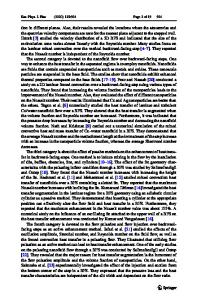Numerical Investigation for Bio-convection Flow of Viscoelastic Nanofluid with Magnetic Dipole and Motile Microorganisms
- PDF / 1,507,376 Bytes
- 12 Pages / 595.276 x 790.866 pts Page_size
- 120 Downloads / 359 Views
RESEARCH ARTICLE-PHYSICS
Numerical Investigation for Bio-convection Flow of Viscoelastic Nanofluid with Magnetic Dipole and Motile Microorganisms Ali Saleh Alshomrani1 Received: 9 June 2020 / Accepted: 23 September 2020 © King Fahd University of Petroleum & Minerals 2020
Abstract Nowadays, the first most crucial condition of modern technological activities is exceptional refrigeration efficiency for standard construction. The thermal and mass efficiency of nanofluid is identified by the Buongiorno relation assessment, which encourages us to specify novel qualities of thermophoretic diffusion and random motion. Nanofluid mechanisms are accomplished in numerous fields like heat exchanger, solar water heating, and vehicle thermal control. The suggested thermoelectric system depends on the density of the flow, the heat of nanomaterial, the fractional volume of nanomaterial and the motile microorganisms. Ferromagnetic-nanoparticles have become extremely popular in bio-technology due to the vast applications in the field. Various technical and mathematical constraints are accounted in order to produce more beneficial data. The necessary conversion method is used to transform a system of PDEs into a collection of non-linear ordinary differential equations. Such transformed expressions are evaluated numerically by the MATLAB function bvp4c by using the shooting scheme. Some observations are elaborated in the literature dealing with the bio-convection process and other unique characteristics. Graphs are shown for the formulation of various flow factors that influence the dimensionless quantities. Current theoretical model may be useful in manufacturing methods, energy transfer upgrades and thermal energy. Keywords Bio-convection · Magnetic dipole · Viscoelastic nanofluid · Activation energy · Motile microorganisms · Numerical solution
1 Introduction Nanofluids are forthcoming new generation heat transfer liquids, which have been analyzed precisely, in recent years. Nanofluids are solid–fluid integrands are developed by submerging of carbides (nano-sized particles: nitrides, graphite, carbon nano-tubes, metals: aluminum, copper, iron and titanium) and oxide metal in a regular fluid (water, ethylene oil have low relocation rate, glycol suspension, kerosene). Nanofluids have innovative significance that makes them advantageous in enormous solicitations in heat transmission. Such nanoparticles improved the thermal aspect as compared to ordinary fluid. As a result, heat transfer tends to exaggerate the thermal conductivity, which in turn makes it very efficient. Due to exceptional heat transfer efficiency (extreme thermal conductivity) nanofluids are commonly uti-
B 1
Ali Saleh Alshomrani [email protected] Department of Mathematics, Faculty of Science, King Abdulaziz University, Jeddah 21589, Saudi Arabia
lized in multiple/numerous fields of technology and medical sciences, such as eradication of tumors by hyperthermia, nuclear system, cooling, X-ray, engine cooling, fuel cells, drilling, micro-fluidics, scientific
Data Loading...











